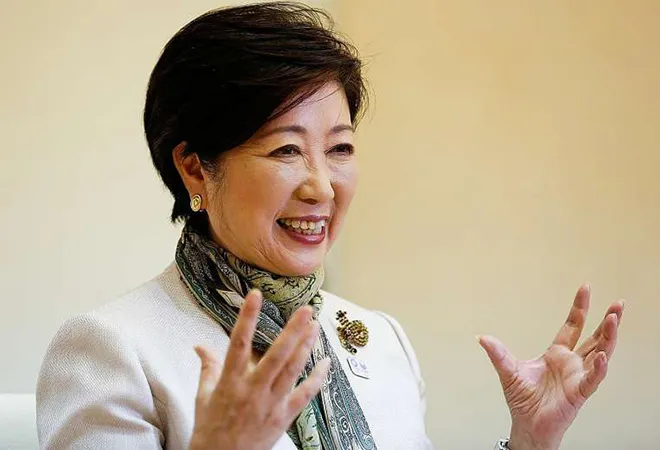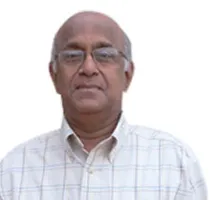
Yuriko Koike, the incumbent governor of Tokyo, has made history by getting re-elected to the post by a huge mandate in the recently held gubernatorial election. Pitted against 21 rival candidates that included important personalities like Kenji Utunomiya, the former head of the federation of bar associations, Koike garnered about 60% of the total number of votes. Knowing Koike’s career trajectory since the 2016 Tokyo gubernatorial election, one does not see anything surprising about her success. She was the first woman to be elected as the governor of Tokyo in 2016 and her re-election now adds one more milestone.
In the electoral scene of Japan, Tokyo occupies a special position as it forms the epicentre of all political and economic activities. With a population of about 14 million people, its economy is as big as Indonesia’s and accounts for 20% of Japan’s GDP. The governor of Tokyo enjoys a certain degree of importance and even prestige in the national affairs of the country.
In the electoral scene of Japan, Tokyo occupies a special position as it forms the epicentre of all political and economic activities. With a population of about 14 million people, its economy is as big as Indonesia’s and accounts for 20% of Japan’s GDP
To be sure, Koike did not have any special interest in Tokyo until she was elected as its governor in 2016. Born in 1952 in the distant Hyogo prefecture, she graduated from the Cairo University and is proficient in the Arabic language. After a stint in the field of journalism, she entered politics during the mid-1990s when Japan suffered from chronic political instability. She was elected to the House of Representatives and tried her fortune with some of the shaky political parties which were short-lived. In 2002 she joined the Liberal Democratic Party (LDP) and stuck with it until 2016 when she left it to contest the Tokyo gubernatorial race. It is important to note that she was close to Prime Minister Koizumi Junichiro in 2003-05 when he was fighting against many hardliners in the party. Koizumi made her the minister in charge of environment and Okinawa affairs. Later, in July/August 2007, she served Prime Minister Abe as minister in charge of defence briefly before she quit, due to controversy regarding a leak in a defence project. In 2008, she even went to the extent of contesting the LDP Presidential election which she lost to Taro Aso. Ideologically, she was considered hawkish because of her strong views on issues like constitutional amendment and the role of the Self-Defence Forces. She was on the same page with Abe on some of these issues. She was a member of the Nihon Kaigi (Japan Conference), a right-wing group of the LDP.
Now that she has been re-elected for a second term, which is unprecedented in the history of Tokyo, she is being brought increasingly under public scanner. What has been her substantial achievement as governor in the first tenure? And what does she seek to achieve in the second term?
Opinion on her contributions during the first tenure is sharply divided. Many critics have accused her of being “overly theatrical” in her approaches to various issues. They say that she was more particular about “style than about substance”. Second, within one year after her election, she formed her own party called Tomin First no Kai (Tokyo First Party), defeated the LDP in the Tokyo Metropolitan election and gained a commanding majority in the legislative assembly. Later, she grew more ambitious and went on to challenge Prime Minister Abe in the Lower House election held in 2017. Her newly founded national party Kibo no To (Party of Hope) turned out to be a disappointment as it dismally failed in the polls. That put a spoke on Koike’s ambitions at the national level.
As for her achievements during her first tenure (2016-2020), the most important issue that she inherited from the previous administration related to the shifting of the famed Tsukiji fish market located in the heart of Tokyo to a new site near Toyosu, a small island in the city. After taking over as the governor, she decided to postpone the relocation project due to the presence of toxic chemicals at the new site. There was a delay of two years before the relocation could be completed, and in the meantime, the cost of the project had escalated beyond anybody’s expectation. Koike had to do a lot of patient negotiations with all parties concerned. She claimed that she had made the relocation process more transparent. Even so, the plan that the old Tsukiji site would be turned into a theme park or international convention venue remains still a big question mark.
After taking over as the governor, she decided to postpone the relocation project due to the presence of toxic chemicals at the new site. There was a delay of two years before the relocation could be completed, and in the meantime, the cost of the project had escalated beyond anybody’s expectation
She also made many electoral pledges on such issues as gender equality, increased child-care facilities, easing of traffic and urban congestion, and improvement of environment. While critics admit that there has been some improvement in child-care facilities, other issues have not been fully addressed by her administration. There is a great deal of expectation that Koike will use her second term for solving some of the pressing issues.
The other two issues which have kept her busy during the first tenure and will continue to engage her close attention are the holding of the 2020 Olympic Games and the tackling of the raging COVID-19 crisis. She considered the holding of the Olympics 2020 in Tokyo as a matter of great prestige to both Tokyo and Japan. She went all out to extend full support to the central government. Within a month of her election as Tokyo governor, she went to Rio de Janeiro to attend the closing ceremony of the Olympics in August 2016 and to receive the Olympics Flag from the mayor of the city. From then on, for four years, she worked in cooperation with the central government and the International Olympics Committee to plan and oversee the various projects connected with the mega event. Later, when the COVID-19 outbreak threatened the Olympics, Koike made utmost efforts to see that the Games were postponed and not altogether cancelled. She is now very keen to hold the event in 2021 even on a restricted scale.
As for COVID-19, Koike played a very effective role in stemming the spread of the virus. In particular, during March-April when there was a rapid surge of Coronavirus cases in Tokyo, she kept in constant touch with the citizens and used effectively certain catchwords like three C’s. (to avoid high-risk confined places, crowded places, and close contact). She called upon the people to work from home and reduce human interaction by 80%. She even differed with Prime Minister Abe on the question of closing business activities in order to fight the virus. She gave subsidies to the small and medium business enterprises to compensate for the losses they suffered during the period. It is also to be noted that she refused to make personal appearances during the election campaigning.
As for COVID-19, Koike played a very effective role in stemming the spread of the virus. In particular, during March-April when there was a rapid surge of Coronavirus cases in Tokyo, she kept in constant touch with the citizens and used effectively certain catchwords like three C’s
Ever since her re-election on 5 July, there has been a resurgence of coronavirus cases in Tokyo and Koike has been making appeals to the people to continue to observe emergency norms like wearing masks, avoiding non-essential outings and work from home. Many observers believe that more than Abe it is Koike who has taken advantage of the COVID-19 crisis to project herself as a dynamic leader and a powerful communicator.
Koike’s resounding victory in the gubernatorial election and her role in fighting the COVID-19 crisis have given rise to speculation that she might try to return to national politics and make a bid for the post of prime minister. With Abe’s tenure of LDP Presidency ending in September 2021, there will be a race for the post. Already many potential candidates are getting ready for the fight. Having burnt her boats with the LDP, it is impossible for Koike to return to the party at this stage. Alternately, she has to float a new national party and try to challenge the powerful LDP which is not easy.
The views expressed above belong to the author(s). ORF research and analyses now available on Telegram! Click here to access our curated content — blogs, longforms and interviews.




 PREV
PREV


